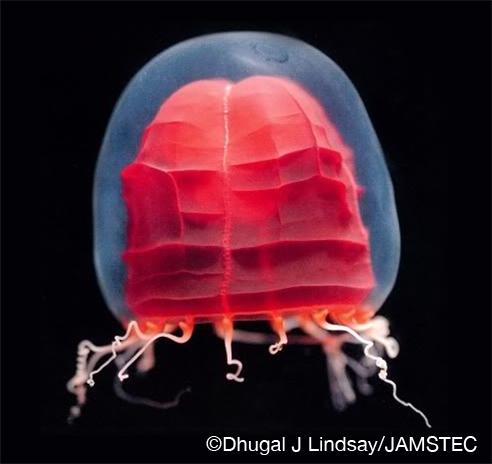Poetry and Taxonomy
When Studio 360 contributor and science reporter Ari Daniel Shapiro visited at the Japanese Agency for Marine-Earth Science and Technology last winter, he was pleased to be met by a friendly and enthusiastic Australian researcher. Dhugal Lindsay explores the deep seas using robotic submersibles carrying video cameras and sampling equipment. He introduced Ari to Pandea rubra, the Red Lantern Jellyfish — it’s the subject of Ari’s podcast for One Species At A Time, a part of the growing online Encyclopedia of Life.
Ari was impressed by Lindsay’s obvious passion for his work, and was pleasantly surprised to discover that the Aussie is fluent in Japanese. In fact, Lindsay gave the Red Lantern Jellyfish its common Japanese name: akachochin kurage.
Akachochin is the term for the red lanterns that hang outside establishments serving liquor and kurage is the Japanese word for jellyfish. He was inspired not just by how the jellyfish looks, but by how it draws creatures to it in the deep sea, much like the glowing red lantern outside a Japanese bar draws thirsty patrons.
But those weren’t the only reasons for the name he chose. Taken together, akachochin kurage fits elegantly into the lines of a haiku poem. References to nature and seasons are important tools of the haiku poet, and Lindsay wants the names of animals not only to be functional, but descriptive and beautiful as well. He has given Japanese names to nearly 50 species.
Lindsay first traveled to Japan as a student in 1991 and became enamored of haiku. Since then, he has become a skilled poet not just in his native language, but in Japanese as well. The president of the Modern Haiku Society of Japan called him “The first Westerner I have come across to make haiku of substance in the Japanese language.” His first haiku collection, Mutsugoro (Mudskipper), won a prestigious award for developing poets, a first for a non-Japanese composing poetry in the Japanese language.
Lindsay’s haiku is inspired by the natural world he investigates. And whenever he has the opportunity to name a newly discovered creature from the ocean depths, he makes sure its name slips smoothly into the pattern of haiku so that it might find its way into the lines of poets.
Here are a few of his poems, composed originally in Japanese and translated into English:
kasa-o sasu sasanai kurage shigure ori
umbrella up
umbrella down, the jellyfish
caught in a shower
seikon-ya hikisakare-taru onihitode
palms pierced
the crown-of-thorns starfish
ripped in two
soryuushi-no naka-ni-mo ryuushi keshi fukare
elemental particles
themselves contain particles
poppies in the wind
Read more of Dhugal Lindsay’s work on his haiku page.
Listen to Ari Daniel Shapiro’s podcast about the Red Lantern Jellyfish for One Species At A Time.
Every day, reporters and producers at The World are hard at work bringing you human-centered news from across the globe. But we can’t do it without you. We need your support to ensure we can continue this work for another year.
Make a gift today, and you’ll help us unlock a matching gift of $67,000!
